Exactly six months since the national emergency was declared, New York’s coronavirus infection rate has stayed below 1 percent for 37 days and counting. Governor Cuomo credits both local enforcement and New Yorkers’ willingness to follow mask and social distancing guidelines for the low numbers, and urges residents to maintain a vigilant attitude to keep numbers low.
However, it remains to be seen whether “New York Tough” will be enough to help the city out of the economic slump caused by the pandemic and the shutdown to contain it. Business leaders from more than 150 companies, including Goldman Sachs, Vornado Realty Trust, JetBlue, and Lyft, sent Mayor de Blasio a letter outlining a grim assessment of New York City quality of life and urging him to take decisive action.
However, it remains to be seen whether “New York Tough” will be enough to help the city out of the economic slump caused by the pandemic and the shutdown to contain it. Business leaders from more than 150 companies, including Goldman Sachs, Vornado Realty Trust, JetBlue, and Lyft, sent Mayor de Blasio a letter outlining a grim assessment of New York City quality of life and urging him to take decisive action.
One Vanderbilt officially opens
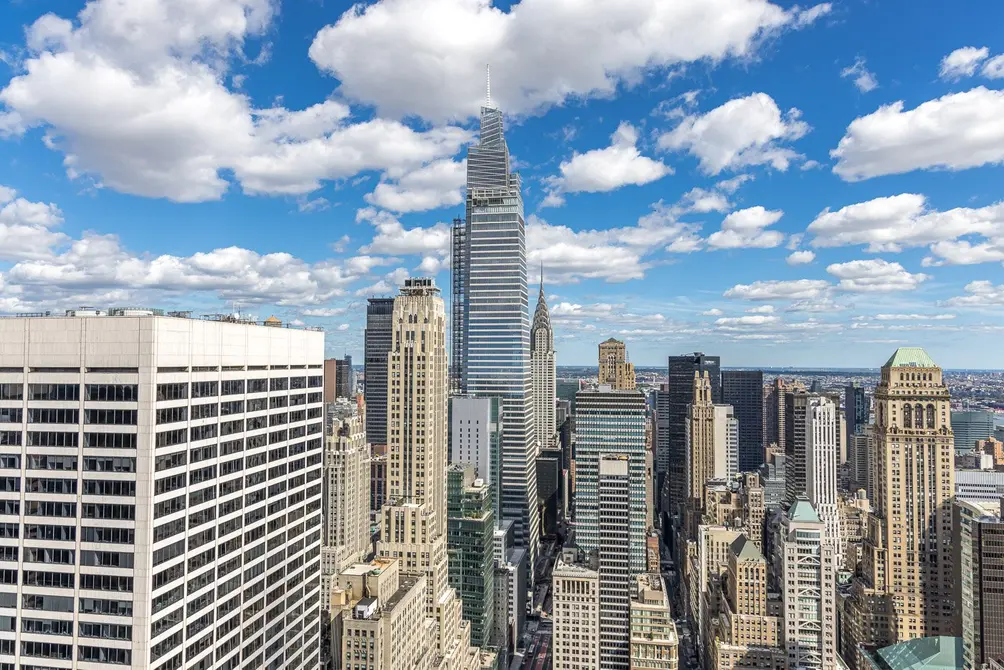 All images of One Vanderbilt via SL Green
All images of One Vanderbilt via SL Green
More than three years after the Midtown East rezoning that allowed for its development, One Vanderbilt officially opened. At a ribbon cutting ceremony for the 1,401-foot-high, 1.7 million-square-foot skyscraper, SL Green Chairman and CEO Marc Holliday said, “One Vanderbilt is already the best address in Manhattan, headquarters to leading global companies and home to the most incredible space and views in New York City.”
The 77-story building’s design by Kohn Pedersen Fox was inspired by the golden age of skyscrapers, but its infrastructure is decidedly up to modern standards: It is on track to receive LEED Gold and WELL certifications, and will be Wired certified for connectivity and technology readiness. The building has established a stand-alone application that allows for a touch-free experience “from turnstiles to elevators,” not to mention thermal imaging technology and MERV-16 air filtration.
The 77-story building’s design by Kohn Pedersen Fox was inspired by the golden age of skyscrapers, but its infrastructure is decidedly up to modern standards: It is on track to receive LEED Gold and WELL certifications, and will be Wired certified for connectivity and technology readiness. The building has established a stand-alone application that allows for a touch-free experience “from turnstiles to elevators,” not to mention thermal imaging technology and MERV-16 air filtration.
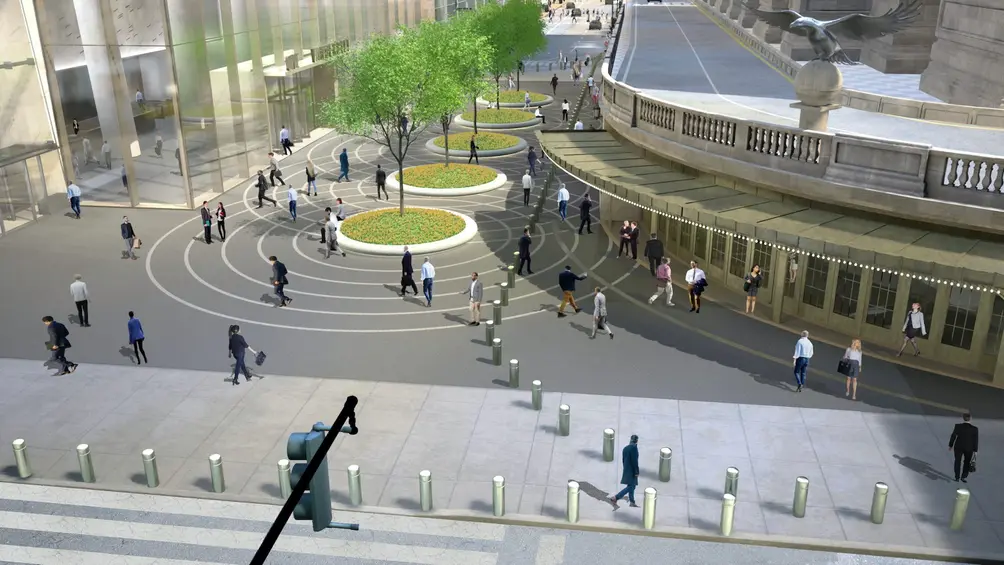
In exchange for the required zoning variances, developer SL Green entered into a public-private partnership with the city and the MTA, committing $220 million for transit improvements around the area. These include two street-level subway entrances for the 4/5/6 trains at Grand Central, new staircases between the mezzanine and platform levels, and a new transit hall to connect Grand Central to a new Long Island Railroad station. Moreover, they created a 14,000-square-foot pedestrian plaza on Vanderbilt Avenue between East 42nd and 43rd Streets. Local workers and tourists would likely embrace the car-free space at any time, and it is especially welcome in this age of social distancing.
One Vanderbilt is 70 percent leased with tenants that include SL Green, TD Bank, TD Securities, Carlyle Group, Greenberg Traurig, KPS Capital Partners, and McDermott Will & Emery. They will have access to an exclusive amenity floor that includes a state-of-the-art auditorium, a 30-seat boardroom, social space, and an expansive terrace overlooking Vanderbilt Plaza.
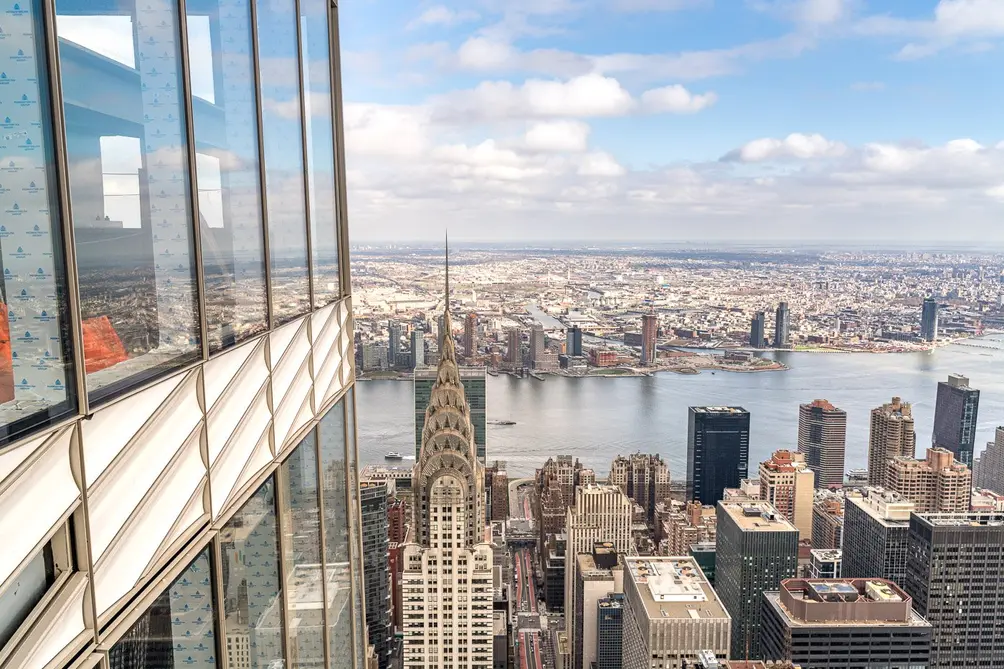
Acclaimed chef Daniel Boulud will provide food for the building’s lounge, and all will have access to a ground-floor branch of Epicerie Boulud and new restaurant Le Pavillon on the second floor. Additionally, an observatory on the 57th to 59th floors dubbed The Summit will be the fourth-highest in the world, coming in just behind the Empire State Building and Edge at Hudson Yards.
Tenant move-ins are expected to begin in November 2020 at the soonest. Le Pavillon is on track to open early next year, and The Summit is set to open later in 2021.
Tenant move-ins are expected to begin in November 2020 at the soonest. Le Pavillon is on track to open early next year, and The Summit is set to open later in 2021.
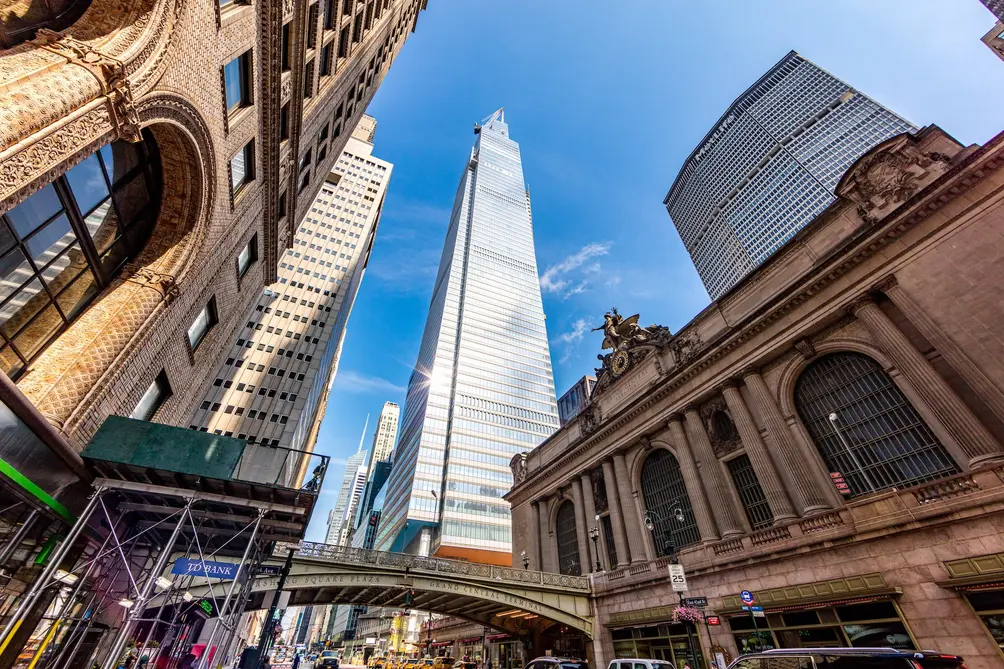
Landmarks to review proposal for rooftop restaurant at W Union Square
On Tuesday, September 15, the Landmarks Preservation Commission (“Landmarks”) will hear a proposal for a rooftop addition at 201 Park Avenue South, an individual landmark on the corner of East 17th Street. The Second Empire Style building completed in 1910-11 was originally the headquarters of Germania Life Insurance (now Guardian Life Insurance), and the 1988 Landmarks designation report describes it as “an early and impressive example of modern signage.”
Today the building is best known as the home of W New York - Union Square, a hip hotel in an unbeatable location where “uptown meets downtown.” The Landmarks presentation from Beyer Blinder Belle notes that before the hotel opened its doors in 2000, the landmark underwent several changes including new signage, a replaced storefront, a new marquee, and rooftop alterations that include removed skylights.
The latest changes are proposed in preparation for a rooftop restaurant. To make this happen, the company seeks to relocate a generator and corridor A/C unit, add an elevator, extend the existing stair bulkhead, extend and enlarge the existing MEP bulkhead, and raise the walking surface for an accessible roof terrace. The existing parapet will remain, but a seasonal structure with retractable glass panels has been proposed.
The presentation cites historic hotel rooftop gardens like those at Hotel Astor, Biltmore Hotel, and Hotel Ritz-Carlton. As a more recent example, the nearby Moxy East Village is a new hotel topped with a seasonal structure. Mock-ups show that the proposed seasonal structure at the W New York - Union Square can be seen from several angles, but it does not overpower the signage or look overly conspicuous.
The presentation cites historic hotel rooftop gardens like those at Hotel Astor, Biltmore Hotel, and Hotel Ritz-Carlton. As a more recent example, the nearby Moxy East Village is a new hotel topped with a seasonal structure. Mock-ups show that the proposed seasonal structure at the W New York - Union Square can be seen from several angles, but it does not overpower the signage or look overly conspicuous.
The hearing takes place nearly a year after Marriott purchased W New York - Union Square with the intention of renovating and transforming it. The rooftop restaurant is a key component, and the hotel’s improvements are also expected to include a signature spa, next-level design, and a new take on W Hotels’ signature Whatever/Whenever concierge service. Anthony Ingham, Global Brand Leader of W Hotels Worldwide, describes the move as “a chance to evolve and redefine the brand right where it all began: New York City.”
Future Streets comes to the Meatpacking District
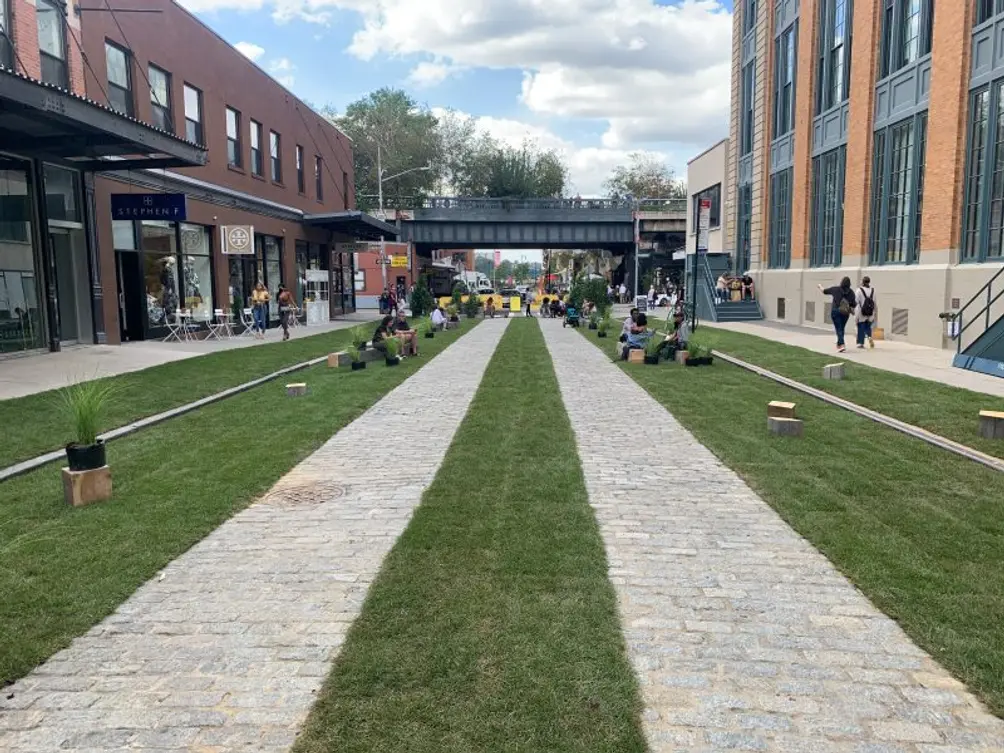 Future Street via Gersh Kuntzman
Future Street via Gersh Kuntzman
The Meatpacking District has gotten increasingly pedestrian-friendly in recent years, and that was taken to a new level over the weekend: From September 11-13, the Meatpacking District BID created a one-block "Future Street" completely closed to cars (no traffic or storage) and featuring a grass-covered stretch with socially distant seating in partnership with the American Institute of Architecture, the American Society of Landscape Architecture, and the American Planning Association.
The sod-covered street encompassed one city block - Gansevoort Street between Washington and Greenwich Streets - but that was enough to attract generous foot traffic. The manager of local business Little West Wine and Spirits observed that her shop saw twice the typical number of customers during the demonstration, and a member of the community board noticed that the grass and tables took the block from unnoticed to beloved.
The Future Streets demonstration only lasted three days, but took place at a time when car traffic is down and many New Yorkers are thinking about new possibilities for the city. As Jonathan Cohn of the American Institute of Architects' Future Streets Committee put it, "People don't want to go back to the bad old days when cars overran the street...We want a better normal."
The sod-covered street encompassed one city block - Gansevoort Street between Washington and Greenwich Streets - but that was enough to attract generous foot traffic. The manager of local business Little West Wine and Spirits observed that her shop saw twice the typical number of customers during the demonstration, and a member of the community board noticed that the grass and tables took the block from unnoticed to beloved.
The Future Streets demonstration only lasted three days, but took place at a time when car traffic is down and many New Yorkers are thinking about new possibilities for the city. As Jonathan Cohn of the American Institute of Architects' Future Streets Committee put it, "People don't want to go back to the bad old days when cars overran the street...We want a better normal."
Permits filed for 29 Jay Street, new DUMBO commercial building
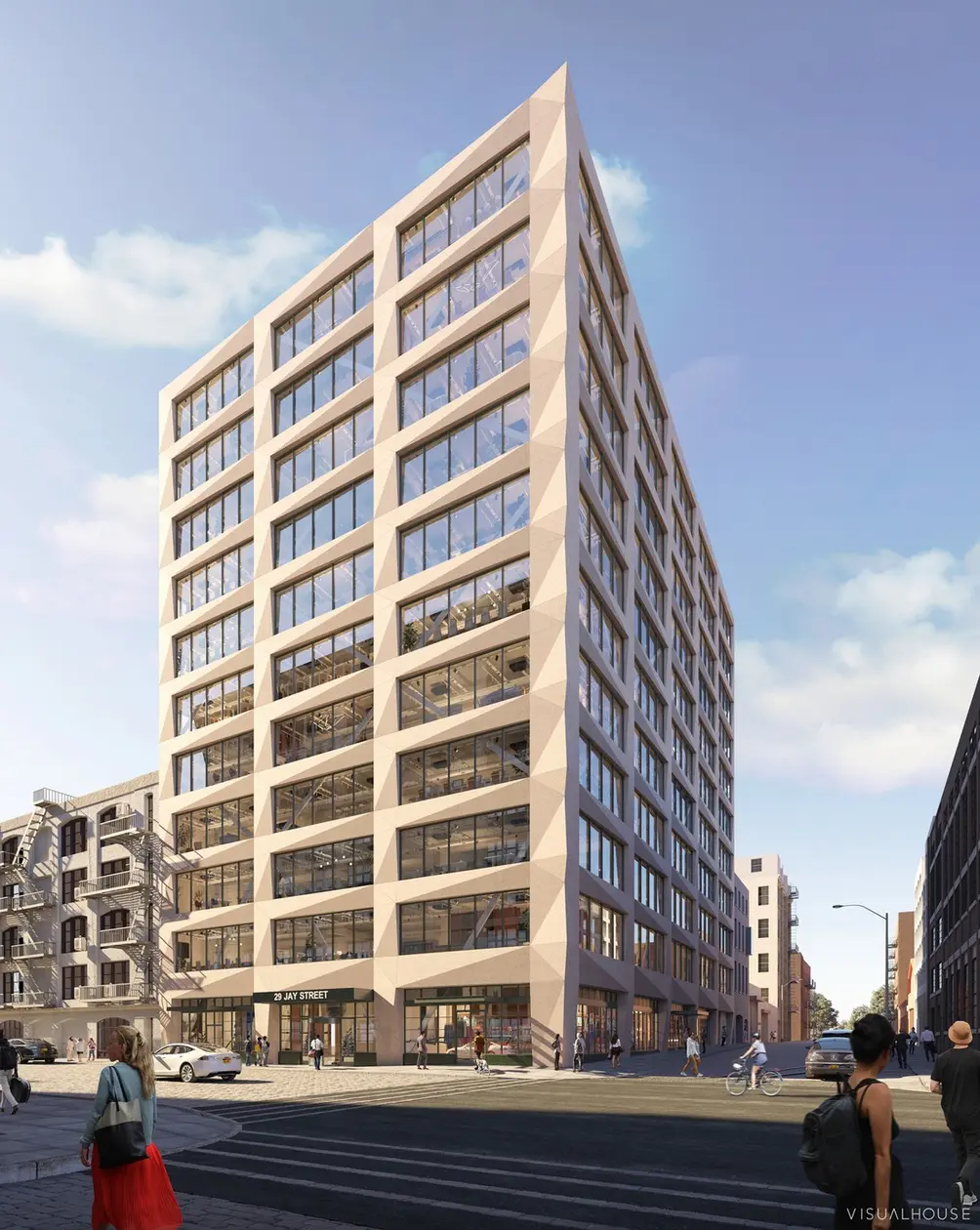 Rendering of 29 Jay Street via Marvel Architects
Rendering of 29 Jay Street via Marvel Architects
About two and a half months after the Landmarks Preservation Commission approved the project with modifications, permits have been filed for 29 Jay Street, a new commercial building in the heart of the DUMBO Historic District. They call for retail space on the ground floor and offices from floors 2-11.
Amenities will include a bike room, cellar-level meeting rooms, and a roof terrace. The design by Marvel Architects will feature geometric prefabricated concrete panels with dramatically angled corners and 9' windows that promise excellent light and views. Moreover, in light of the Climate Mobilization Act, proposed mechanicals include a state-of-the-art cooling tower, gas-fired boiler, and water-cooled VRF units and ventilation systems.
Amenities will include a bike room, cellar-level meeting rooms, and a roof terrace. The design by Marvel Architects will feature geometric prefabricated concrete panels with dramatically angled corners and 9' windows that promise excellent light and views. Moreover, in light of the Climate Mobilization Act, proposed mechanicals include a state-of-the-art cooling tower, gas-fired boiler, and water-cooled VRF units and ventilation systems.

 6sqft delivers the latest on real estate, architecture, and design, straight from New York City.
6sqft delivers the latest on real estate, architecture, and design, straight from New York City.
